Legacy of a Runaway Slave who Changed Donegal Ireland and the World
Donegal County is rich in a variety of superb ancient Celtic stonework.
Ring forts, decorative carvings, remote hermitage sites and more wait to be explored, waiting to carry you off into the mysterious world of the past.
No matter where you go in Donegal, you're never far from several fine examples. It's well worth seeking them out.
Amazingly, few people are aware of the wonderful Celtic history these masterfully crafted structures conceal. A history almost as breathtaking as the county's beautiful landscape. So . . .
Let's Take a Step Back In Time to Explore
The year was AD386. It was a time of barbarism and terror in Donegal County, in Ireland, and abroad. Villages were plundered. Cattle, women and children
were carried away, the women and children sold into slavery. Celtic families depended on the might of their chieftains and kings for
military defense.
Niall of the Nine Hostages was reigning High King of Ireland.
The High King was father of among others, the great Celtic kings Conall and Eoghain
who were kings in Donegal County, and of future High King of Ireland
Laeghaire MacNiall.
An event had just occurred that would trigger profound change in the future lives
of High King Niall's sons and descendents forever. A change that would spread like
wildfire through all of society.
Such events were regular occurrences at the time. And not even the High King himself could have known that anything was different on this occasion.
However, this particular shipment of foreign children, snatched in a raid for the Irish pagan Celtic slave market, included a very special teenage boy.
Of ancient Celtic nobility, born under Roman occupation, that teen was destined to change the course of Irish and world history forever.
Not least
the history of Donegal County.
His Name was Succat (but that would Change)
At age sixteen, Succat was forced to tend livestock on Slemish mountain in the province of Ulster. Everything was foreign to him, including the language.
Frightened and alone, that enslaved youth turned to God. He spent hours day and night in Christian prayer learned as a child. His only human company was the occasional visit from his slave-master's children, from whom he learned Gaelige, the ancient language of the Celts.
After six desolate years on the mountain, Succat received two spoken messages in his dreams. The first said he would soon return home and, some time later the second said a ship some 185 miles to the south was ready to take him there.
Succat Escapes, Becomes a Bishop, Receives a New Name
Eventually Succat reached that ship with the help and kindness of the Uí Tuirtre clan and Victoricus whom he had met on his journey near Lough Neagh, or 'western sea' as he called it.
It was for the Uí Tuirtre that Succat translated 'The Lord's Prayer' from his Latin to their native Gaelige.
He sailed back home at age twenty two from where he embarked on a spiritual life, becoming a priest and later a Bishop.
Succat was given a new name, Patricius (Patrick) by Pope Saint Celestine The First.
"We Beg you, Holy Youth, Come Back...
and Walk Once More Among us!"
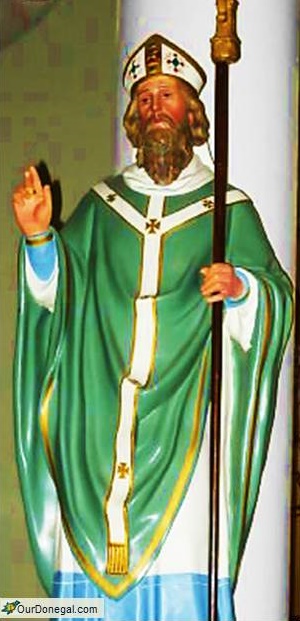 Saint Patrick of Ireland
Saint Patrick of IrelandOne night in a dream, Patricius, as Succat was now known, had a vision. Victoricus and the Uí Tuirtre were calling him back to Ireland, crying out as if with one voice, the voice of the Irish "Come back and stay another while with us".
Deeply moved by the vision, Patricius
returned to Ireland in AD432 and devoted the next thirty years until his
death to Christianizing the Celts in Ireland.
They Called him Pádraig, Gaelige for Patrick
Having secured the permission and protection of Laeghaire MacNiall the then High King of Ireland, Patrick traveled throughout the land.
In the face of hostility and danger, he converted, blessed and baptized the people of Ireland from the deeply rooted paganism of the Celtic druids to Christianity and peace, starting with the Uí Tuirtri and Victoricus.
Many of the druids converted.
Celtic Kings of Donegal County Embrace Christianity
In time, Patrick made his way to Donegal County where he was welcomed by both Conall Gulban and Eoghain, sons of Niall, kings of Donegal.
Conall had already been converted to Christianity, being Ireland's
first baptized nobleman. Eoghain embraced the faith later in
Inishowen.
King Conall's Shield
According to ancient manuscripts and local tradition, Patrick struck King Conall's shield with his crosier. As a result, the shield was permanently marked with the sign of the Cross.
Patrick then assured Conall that he and his descendents
would always be victorious as long as they remained faithful
to Christ and followed His sign.
Colmcille and Saint Patrick's Prophesy
Patrick arrived at Mullaghnashee near Ballyshannon and gave King Conall a blessing.
He then blessed the king's young son, Ferghus Cennfada, prophesying that one of his descendants would be a sage, a prophet and a poet.
Two generations later the grandson of Ferghus, the future Saint
Colmcille was born in Gartan, Donegal County.
The greatest of Ireland and Donegal's many great saints, Saint Columba as he is sometimes called is one of five Donegal saints, from a total of forty one saints of the ancestoral lineage of Niall through Conall.
Among his many achievements, Saint
Colmcille established a famous monastic
community on the island of Iona Scotland.
Saint Patrick in Inishowen and the Baptism of King Eoghain
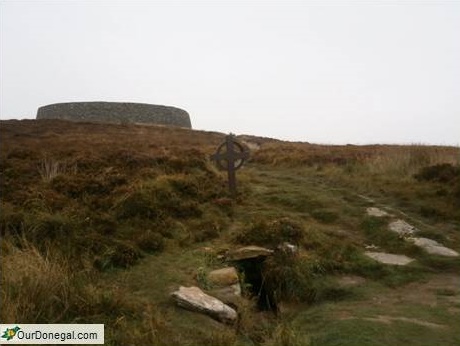 St.Patrick's Well. King Eoghain baptism site
St.Patrick's Well. King Eoghain baptism sitePatrick then made his way to Inishowen. He traveled northward through Barnesmore Gap
in the beautiful Bluestack mountain range and, meeting Eoghain,
persuaded him to convert to Christianity.
Eoghain was subsequently baptized along with his grandson Echaid at a well that has since become known as Saint Patrick's well, beside the Grianán Áilligh fort.
Blessing Eoghain and his descendants, 'Áileach of the Kings', and Inishowen in the distance, Patrick prophesied that the kings and prelates of Aileach would rule forever provided they remain faithful to Christ.
The name of the powerful O'Neill dynasty has
since been carried through the lineage of Eoghain.
The Legacy of the Celebrated Saint, Patrick of Ireland
Thanks to the phenomenal achievements of Saint Patrick, Ireland, including Donegal County
has been blessed with numerous saints.
8 Donegal Saints of O'Neill Lineage
And Locations of their Monastic Communities...
Donegal Saints of King Eoghain's Lineage
- Saint Ernan of Tory Island
- Saint Lughaidh of Clonleigh, near Lifford
- Saint Mura of Fahan, in Inishowen
Donegal Saints of King Conall's Lineage
- Saint Crone of Templecrone, near Dungloe
- Saint Conald Coel and
- Saint Conall, both of Inishkeel, near Ardara
- *Saint Bairrfhionn of Kilbarron
- Saint Colmcille of Iona Scotland and more
* Saint Bairrfhionn appears to have been the first European discoverer of America,
preceding both Saint Brendan The Navigator and Christopher Columbus.
(Canon O'Hanlon's 'Lives of the Irish Saints', Article i, Chapter ii, May 21. Link opens new window.)
Saints Barron and Columba
For more information about Saint Barron and Saint Columba, click here, then follow the 'Kilbarron Church' link under 'Ballyshannon'.
Carndonagh and Lough Derg
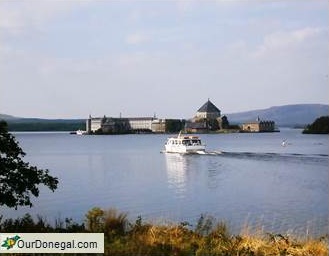 'Saint Patrick's Purgatory', Lough Derg
'Saint Patrick's Purgatory', Lough DergPatrick established, among others a flourishing church near Carndonagh on the Inishowen peninsula and a place of penitential pilgrimage on Station Island, Lough Derg, also known as St Patrick's purgatory.
St Patrick's Purgatory became renowned throughout Europe drawing numerous pilgrims from every corner of the continent.
The tradition of pilgrimage continues at Lough Derg today.
The Global Influence and Appeal of Saint Patrick Patron Saint of Ireland
Not long after his death in AD461, in recognition and gratitude of his phenomenal achievements, Patrick was made Patron Saint of Ireland along with Saint Colmcille and Saint Bridget.
The strong faith of the Irish quickly flowed out beyond Ireland to other countries. As a result, Ireland became known as the Island of Saints and Scholars, attracting students and religious from all over Europe.
Over the centuries as the people of Ireland emigrated and started new lives throughout the world, many of them from Donegal County, they carried their Christian faith with them to every part of the world as they and their descendants became involved at all levels in their new communities.
Saint Patrick's uplifting message of peace for mankind went global.
Today, that young runaway slave, who is still making a difference in the lives of so many over fifteen hundred years later, St.Patrick is honored and celebrated throughout the world every year on the 17th of March.
A very happy Saint Patrick's Day to you!
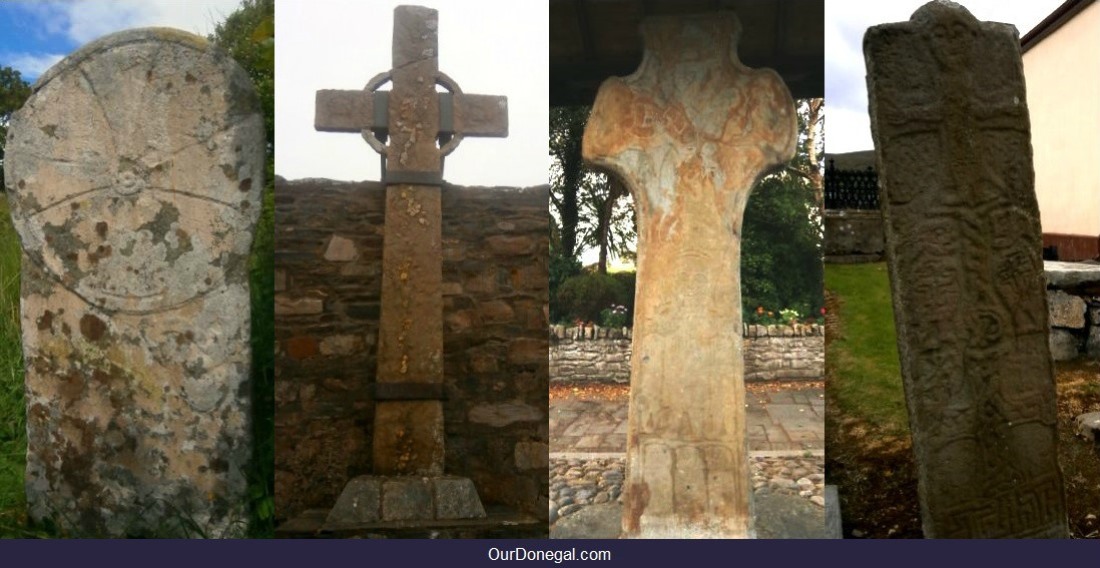
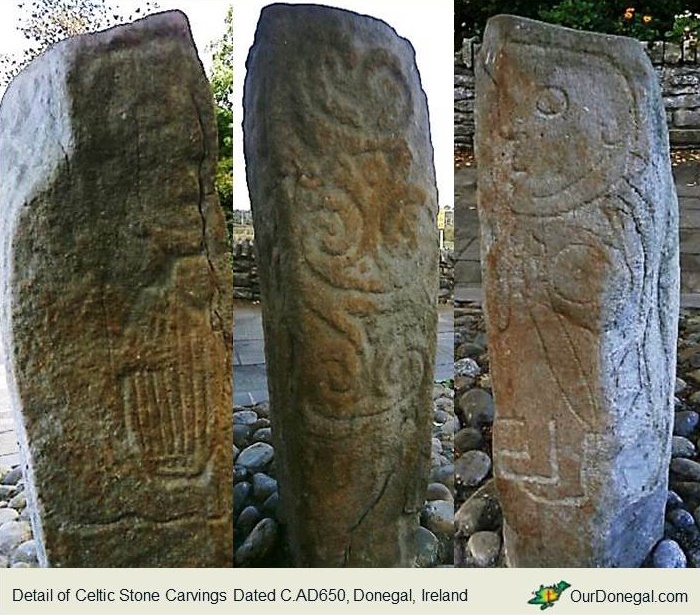
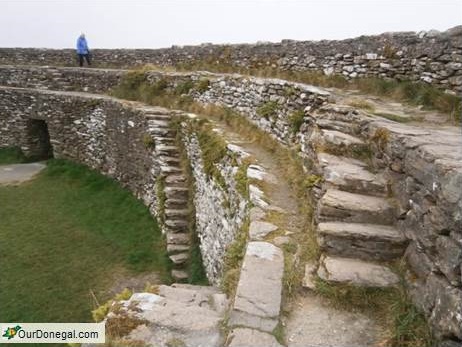
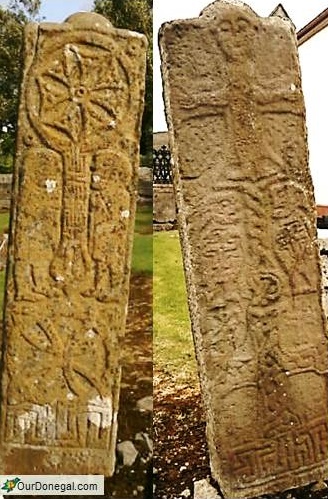
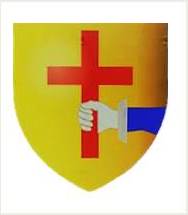
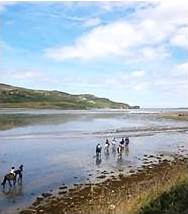
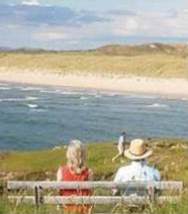


New! Facebook Comments